 W
WA maze is a path or collection of paths, typically from an entrance to a goal. The word is used to refer both to branching tour puzzles through which the solver must find a route, and to simpler non-branching ("unicursal") patterns that lead unambiguously through a convoluted layout to a goal. The pathways and walls in a maze are typically fixed, but puzzles in which the walls and paths can change during the game are also categorised as mazes or tour puzzles.
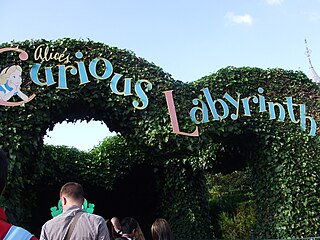 W
WAlice's Curious Labyrinth is a hedge maze attraction at the Disneyland Park within Disneyland Paris. It opened in 1992 with the Park, and belongs to the British part of Fantasyland. A similar maze attraction, based on both the 1951 and 2010 Disney film adaptations of Lewis Carroll's Alice in Wonderland, exists at Shanghai Disneyland Park.
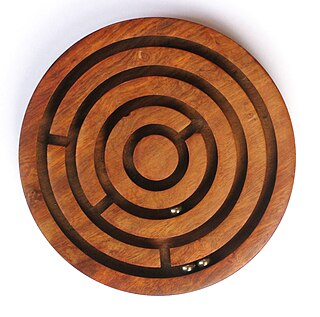 W
WBall-in-a-maze puzzles are dexterity puzzles which involve manipulating either a maze or one or several balls so that the ball or balls are manoeuvered towards a goal. Toys like this have been popular since "Pigs in Clover" was invented by Charles Martin Crandall in the 1880s, with the patent being applied for in 1889.
 W
WBlenheim Palace is a country house in Woodstock, Oxfordshire, England. It is the seat of the Dukes of Marlborough and the only non-royal, non-episcopal country house in England to hold the title of palace. The palace, one of England's largest houses, was built between 1705 and 1722, and designated a UNESCO World Heritage Site in 1987.
 W
WA caerdroia is a Welsh turf maze, usually in the sevenfold Cretan labyrinth design. They were created by shepherds on hilltops and were apparently the setting for ritual dances, the nature of which has been lost. At the centre of each caerdroia was a small hillock—in Welsh, twmpath. A gathering for folk dancing in Wales is still called a twmpath dawns. It is a typical labyrinth of Welsh but there is a specimen in Italy to Petrella Tifernina discovered by the historian Mario Ziccardi. This specimen is the only one in the Mediterranean area for now.
 W
WChatsworth House is a stately home in Derbyshire, England, in the Derbyshire Dales, 3.5 miles (5.6 km) north-east of Bakewell and 9 miles (14 km) west of Chesterfield. The seat of the Duke of Devonshire, it has been home to the Cavendish family since 1549, standing on the east bank of the River Derwent, across from low hills between the Derwent and Wye valleys. The house is set in expansive parkland backed by wooded, rocky hills that rise to heather moorland. It contains major collections of paintings, furniture, Old Master drawings, neoclassical sculptures, books and other items. Chatsworth has been chosen several times as Britain's favourite country house.
 W
WChenies Manor House in the parish of Chenies in Buckinghamshire, England, is a Tudor Grade I listed building once known as Chenies Palace, although it was never a royal seat nor the seat of a bishop. It was held by the Cheney family since 1180 and passed by marriage successively to the Semark and Sapcote families and thence in 1526 to the Russell family, Earls of Bedford, later Dukes of Bedford, by whom it was held for several centuries. Although the Russells soon abandoned Chenies as its main seat in favour of Woburn Abbey in Bedfordshire, Chenies parish church remains the site of the private "Bedford Chapel", the mausoleum still in use by that family.
 W
WCliveden is an English country house and estate in the care of the National Trust in Buckinghamshire, on the border with Berkshire. The Italianate mansion, also known as Cliveden House, crowns an outlying ridge of the Chiltern Hills close to the South Bucks villages of Burnham and Taplow. The main house sits 40 metres (130 ft) above the banks of the River Thames, and its grounds slope down to the river. Cliveden has become one of the National Trust's most popular pay-for-entry visitor attractions, hosting 524,807 visitors in 2019.
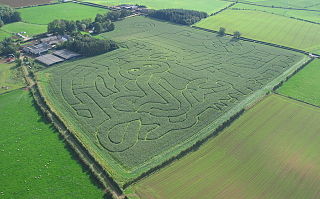 W
WA corn maze or maize maze is a maze cut out of a corn field. Originally, the first full-size corn maze was believed to be created in Annville, Pennsylvania in 1993; however, similar corn mazes were highlighted in newspapers as early as 1982. Corn mazes have become popular tourist attractions in North America, and are a way for farms to generate tourist income. Many are based on artistic designs such as characters from movies. Corn mazes appear in many different designs. Some mazes are even created to tell stories or to portray a particular theme. Most have a path which goes all around the whole pattern, either to end in the middle or to come back out again, with various false trails diverging from the main path. In the United Kingdom, they are known as maize mazes, and are especially popular with farms in the east of England. These mazes are normally combined with other farm attractions of interest to families and day trippers. Some of these attractions include hay rides, a petting zoo, play areas for children, and picnic areas. Each year a few of the mazes are featured in national newspapers and TV. In the U.S., corn mazes typically are cut down circa the first week of November; in the UK typically in September after children return to school.
 W
WThe Edmonton Corn Maze is a popular attraction west of Edmonton, Alberta.
 W
WThe Exploratorium is a museum of science, technology, and arts in San Francisco. Characterized as "a mad scientist's penny arcade, a scientific funhouse, and an experimental laboratory all rolled into one", the participatory nature of its exhibits and its self-identification as a center for informal learning has led to it being cited as the prototype for participatory museums around the world.
 W
WThe Fort Custer Maze was a 2-mile (3.2 km) long maze enclosed within an 1850s western style fort located in Clear Lake, Iowa. It closed in October 2015 after being in operation for 15 years.
 W
WGlendurgan Garden is a National Trust garden situated above the hamlet of Durgan on the Helford River and near Mawnan Smith, in the civil parish of Mawnan, Cornwall, England, United Kingdom.
 W
WGreys Court is a Tudor country house and gardens in the southern Chiltern Hills at Rotherfield Greys, near Henley-on-Thames in the county of Oxfordshire, England. Now owned by the National Trust, it is located at grid reference SU725834, and is open to the public.
 W
WHabitrail is a brand name for a hamster cage made by the Hagen corporation. It is a series of translucent plastic tubes and "houses" for use in home terrariums, designed specially for hamsters. The design of the Habitrail is modular and can be configured however the owner likes, as well as disassembled for cleaning. The Habitrail is meant to mimic the habitat of the animal in question, usually a warren, or series of tunnels. The mascot for Habitrail is "Herbie the Hamster", who even has a video game based on him called Habitrail Hamster Ball produced by Data Design Interactive in 2005 and released for the PS2, and the PC.
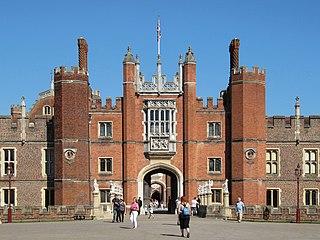 W
WHampton Court Palace is a Grade I listed royal palace in the London Borough of Richmond upon Thames, 12 miles south west and upstream of central London on the River Thames. Building of the palace began in 1514 for Cardinal Thomas Wolsey, the chief minister of King Henry VIII. In 1529, as Wolsey fell from favour, the cardinal gave the palace to the king to check his disgrace. The palace went on to become one of Henry's most favoured residences; soon after acquiring the property, he arranged for it to be enlarged so that it might more easily accommodate his sizeable retinue of courtiers. Along with St James' Palace, it is one of only two surviving palaces out of the many the king owned. The palace is currently in the possession of Queen Elizabeth II and the Crown.
 W
WA hedge maze is an outdoor garden maze or labyrinth in which the "walls" or dividers between passages are made of vertical hedges.
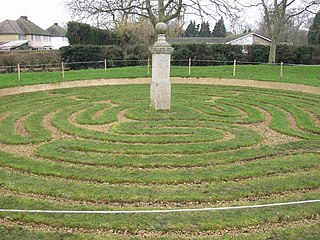 W
WHilton is a village and civil parish in Cambridgeshire, England. Hilton lies approximately 11 miles (18 km) north-west of Cambridge. Hilton is situated within Huntingdonshire, which is a non-metropolitan district of Cambridgeshire as well as being a historic county of England. The parish adjoins those of Elsworth, Fenstanton, Hemingford Abbots, Hemingford Grey, Papworth Everard and Papworth St Agnes. The Church of England parish church is dedicated to St Mary Magdalene and is a Grade I listed building; it has a peal of six bells. Historically, the village was in Huntingdonshire for over 1,000 years until 1974.
 W
WJulian's Bower or Julian Bower is a name which was given to turf mazes in several different parts of England. Only one of this name still exists, at Alkborough in North Lincolnshire. It has also been known by corrupted forms of the name, such as "Gillian's Bore" and "Gilling Bore".
 W
WIn Greek mythology, the Labyrinth was an elaborate, confusing structure designed and built by the legendary artificer Daedalus for King Minos of Crete at Knossos. Its function was to hold the Minotaur, the monster eventually killed by the hero Theseus. Daedalus had so cunningly made the Labyrinth that he could barely escape it after he built it.
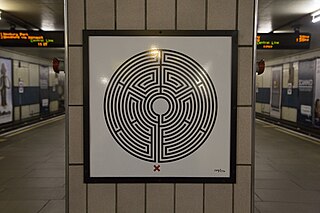 W
WLabyrinth is a 2013 artwork by the British artist Mark Wallinger which marks the 150th anniversary of the London Underground.
 W
WThe Lavender Labyrinth is a 3-acre large garden that resides about 1.5 miles south of Silver Lake in Shelby, Michigan and minutes away from the shores of Lake Michigan. It is located at Cherry Point Farm & Market, which is owned by Barbara Bull. Cherry Point Farm, opened in 1961, is the oldest farm market in Oceana County. Additionally, the labyrinth is also large enough so that it can be seen aerially from space.
 W
WLeeds Castle is a castle in Kent, England, 5 miles (8 km) southeast of Maidstone. It is built on islands in a lake formed by the River Len to the east of the village of Leeds.
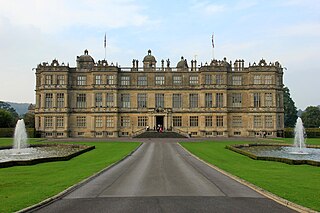 W
WLongleat is an English stately home and the seat of the Marquesses of Bath. A leading and early example of the Elizabethan prodigy house, it is adjacent to the village of Horningsham and near the towns of Warminster and Westbury in Wiltshire and Frome in Somerset. It is noted for its Elizabethan country house, maze, landscaped parkland and safari park. The house is set in 1,000 acres (400 ha) of parkland landscaped by Capability Brown, with 4,000 acres (1,600 ha) of let farmland and 4,000 acres (1,600 ha) of woodland, which includes a Center Parcs holiday village. It was the first stately home to open to the public, and the Longleat estate includes the first safari park outside Africa.
 W
WMagnolia Plantation and Gardens is a historic house with gardens located on the Ashley River at 3550 Ashley River Road west of Ashley, Charleston County, South Carolina. It is one of the oldest plantations in the South, and listed on the National Register of Historic Places. Magnolia Plantation is located near Charleston and directly across the Ashley River from North Charleston. The house and gardens are open daily; an admission fee is charged.
 W
WThe Man in the Maze is a science fiction novel by American writer Robert Silverberg, originally serialized in the magazine, Worlds of If April in May 1968, and published in bookstores the following year. It tells the tale of a man rendered incapable of interacting normally with other human beings by his uncontrollable psychic abilities. The novel is inspired by Sophocles' play Philoctetes, with the roles of Odysseus, Neoptolemus and Philoctetes played by Boardman, Rawlins, and Muller, respectively.
 W
WMaze generation algorithms are automated methods for the creation of mazes.
 W
WThere are a number of different maze-solving algorithms, that is, automated methods for the solving of mazes. The random mouse, wall follower, Pledge, and Trémaux's algorithms are designed to be used inside the maze by a traveler with no prior knowledge of the maze, whereas the dead-end filling and shortest path algorithms are designed to be used by a person or computer program that can see the whole maze at once.
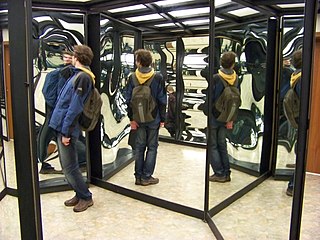 W
WA house of mirrors or hall of mirrors is a traditional attraction at funfairs (carnivals) and amusement parks. The basic concept behind a house of mirrors is to be a maze-like puzzle. In addition to the maze, participants are also given mirrors as obstacles, and glass panes to parts of the maze they cannot yet get to. Sometimes the mirrors may be distorted because of different curves, convex, or concave in the glass to give the participants unusual and confusing reflections of themselves, some humorous and others frightening.
 W
WMizmaze is the name given to two of England's eight surviving historic turf mazes, and also to a third, presumably once similar site that is now merely a relic. Of the two which survive, one is at Breamore, in Hampshire; the other is on top of St Catherine's Hill, overlooking the city of Winchester, Hampshire.
 W
WThe Mohonk Mountain House, also known as Lake Mohonk Mountain House, is an American resort hotel located on the Shawangunk Ridge in Ulster County, New York. Its location in the town of New Paltz, New York is just beyond the southern border of the Catskill Mountains, west of the Hudson River.
 W
WNokkakivi is an amusement park in Lievestuore, Laukaa, Finland. It is located along the Highway 9 (E63), and the distance from the amusement park to the nearest big city, Jyväskylä, is 24 kilometres (15 mi). It is owned by Bellingham Oy.
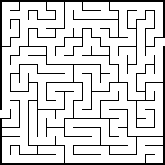 W
WA picture maze is a maze puzzle that forms a picture when solved.
 W
WPuzzling World is a tourist attraction near Wanaka, New Zealand. It began as a single storey maze in 1973, gradually expanding to become an award-winning complex of optical illusions and puzzling rooms and the world's first 3-D maze. Puzzling World is well known for its Leaning Tower of Wanaka and eccentric lavatory styled as a Roman bathroom. As of 2020 Puzzling World had received in excess of 4 million visitors and now attracts around a 200,000 people a year.
 W
WSomerleyton Hall is a country house and 5,000-acre (2,000 ha) estate near Somerleyton and Lowestoft in Suffolk, England owned and lived in by Hugh Crossley, 4th Baron Somerleyton. The hall is Grade II* listed on the National Heritage List for England, and its landscaped park and formal gardens are also Grade II* listed on the Register of Historic Parks and Gardens. The formal gardens cover 12 acres (4.9 ha). Inspired by Knepp Wildland, Somerleyton is rewilding 1,000 acres (400 ha) of the estate to which he has introduced free-roaming cattle, large black pigs and Exmoor ponies.
 W
WThe stone labyrinths of Bolshoi Zayatsky Island are a group of 13 or 14 labyrinths on Bolshoy Zayatsky Island, one of the Solovetsky Islands in Arkhangelsk Oblast, Russia. Lacking standard archaeological study, a research group from St. Petersberg theorize that the labyrinths are about 2500 years old, according to their orientation, their supposed ritual use, and changes in the direction of the zenith on the solstice throughout history.
 W
WAdham Khan's Tomb is the 16th-century tomb of Adham Khan, a general of the Mughal Emperor Akbar. He was the younger son of Maham Anga, Akbar's wet nurse thus also his foster brother. However, when Adham Khan murdered Akbar’s favourite general Ataga Khan in May 1561, Akbar immediately ordered his execution by defenestration from the ramparts of the Agra Fort.
 W
WMany turf mazes in England were named Troy Town, Troy-town or variations on that theme presumably because, in popular legend, the walls of the city of Troy were constructed in such a confusing and complex way that any enemy who entered them would be unable to find his way out. Welsh hilltop turf mazes were called "Caerdroia", which can be translated as "City of Troy".
 W
WHistorically, a turf maze is a labyrinth made by cutting a convoluted path into a level area of short grass, turf or lawn. Some had names such as Mizmaze, Troy Town, The Walls of Troy, Julian's Bower, or Shepherd's Race. This is the type of maze referred to by William Shakespeare in A Midsummer Night's Dream when Titania says
 W
WWorden Park is a large area of parkland situated on the outskirts of Leyland, a town in the borough of South Ribble, Lancashire, England. It is less than a quarter of a mile from the town centre.